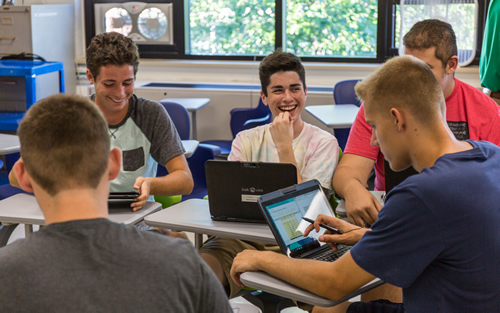As the director of student learning at a pre-K-12 school district, my job is to deploy technology that will prepare students for college and career readiness. So, when my district’s 1:1 computer environment had fallen behind others in our area, it was up to me and my team to roll out something new—something better—that would position our students for future success.
Here’s how we pulled it off and steps you can take to replicate success in your schools.
1. Do your research.
Most of the schools in our region use Chromebooks, but we wanted technology that would grow with us—something with staying power in math and science, especially. To make the most informed decision, we:
- Called community colleges, four-year colleges, and Ivy League universities to get a better picture of the edtech ecosystem our students must be prepared for.
- Used Kahoot! and email management software LISTSERV to collect perspectives from students, parents, teachers, and other tech leaders.
- Created Venn diagrams to weigh the pros and cons of Microsoft vs. Google as learning platforms.
- Held meetings with the Board of Education and tech leaders to identify the best devices, services, and support (at the most agreeable price points).
- Conducted focus groups and device testing with teachers to collect authentic feedback.
- Considered the required tools and resources that would prepare us for the state’s assessment protocol.
2. Get buy-in from key stakeholders.
Students and families need to know what they’ll be getting, how it will be used, and what constitutes responsible behavior. Engage your school community (students, families, faculty, staff, Board) in the decision-making process so they can share the excitement. Creating an authentic sense of ownership early on will strengthen user adoption/support at home, in the classroom, and on the go—all of which results in the best success.
To promote buy-in, we:
- Sent newsletters that educated our stakeholders about our initiative, rationale, and anticipated outcomes.
- Shared social media updates to keep people informed and generate enthusiasm for our rollout.
- Published, posted, and mailed a personalized learning device agreement that established expectations and responsibilities for students and parents.
With buy-in from the overwhelming majority of our school community prior to those all-important first days of school, we were able to start the school season strong.
3. Test it out.
A district-wide technology initiative is expensive and time-consuming. Getting it wrong can set learning back years. So play it safe and test your tech before you buy.
During our research phase, we asked multiple vendors if we could borrow up to 30 devices for testing over a 60-day period. (Only one vendor said yes.) With a hands-on experience in our math, ELA, science, and foreign language classrooms, we were able to see how the devices performed, troubleshoot any issues that cropped up, and find out just what kind of support we could expect from our vendor.
4. Prep your environment.
Consider how you want students to use the device and how your IT infrastructure may need to change to complement your new technology throughout the building. Questions include:
- Where will kids use their devices most?
- Are there internet access points in these areas?
- How will these computers interact with our current classroom technology?
- Do we need to redesign our learning environment? How?
- What charging solutions are necessary?
We made sure that our kids could access the internet in commonly shared spaces such as our courtyard and cafeteria. We replaced outdated interactive whiteboards with new smart TVs that can connect to our new computers wirelessly. We also created more colorful, collaborative classrooms with portable furniture that supports a 1:1 learning environment.
5. Train early and often.
With careful planning, prepping, and training, our teachers have achieved a 90-percent success rate with using the new technology. Here are some methods that worked for us:
- “Train the trainer” sessions
- Professional learning communities
- In-person sessions at the end of the academic year
- Proof-of-concept testing with teachers
- Microsoft Innovative Educator online tutorials
- Full day of professional development
6. Be flexible and stay on track.
Nothing is perfect. Expect some missteps because they’re going to happen. Best advice? Be proactive whenever possible. Make sure you have extra tools and resources at the ready: extra chargers, backup styluses, and support staff in as many classrooms as possible.
If you have carefully vetted your vendor, you will get the best possible customer experience. With quick access to customer support, we were able to exchange emails and receive personalized video messages that were specific to our needs.
7. Choose a technology partner.
Rolling out a new tech plan can be intimidating, so choose the technology provider that’s less of a vendor and more of a partner. After our 2+ years of researching, testing, and prepping, we chose the technology partner that made our small team feel large. Ultimately, we chose the Atlas 2-in-1 laptop from Bak USA because the company shares our commitment to education, and the customer experience was second to none.
- High school students say AI will change the workforce - April 18, 2024
- Motivating students using the Self-Determination Theory - April 17, 2024
- Michigan Virtual’s statewide workgroup releasing AI guidance for K-12 educators - April 17, 2024

